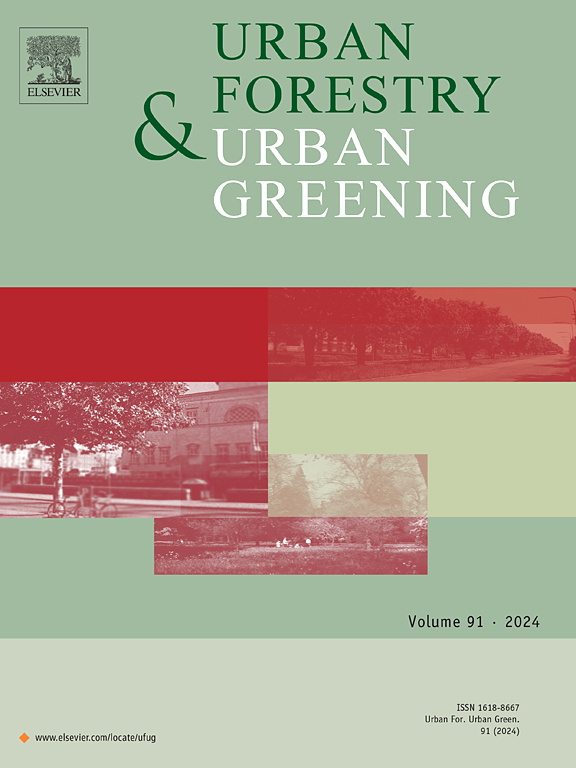确定低收入社区老年人对公园更新的需求:一种公民科学方法
IF 6
2区 环境科学与生态学
Q1 ENVIRONMENTAL STUDIES
引用次数: 0
摘要
公园在促进健康老龄化方面具有巨大潜力,然而,老年人在公园游客中所占比例不足,这表明目前的公园设计可能无法充分满足他们的需求和偏好。这可能是因为老年人经常被排除在城市绿地的规划和开发过程之外。这项参与性研究涉及生活在低收入社区的老年人,他们参与了比利时城市公园重建的阶梯式公园设计过程。本研究(1)确定老年人认为对促进公园旅游、公园体育活动、社会互动和放松重要和渴望的社会和物理公园特征;(2)探索老年人对已确定的公园物理特征的具体设计偏好。本研究由三个部分组成:(1)建立老年公民科学家行动小组,(2)行走访谈,(3)焦点小组访谈。结果表明,长凳高度高于标准,有扶手和靠背支撑,方便和安全的步行路径,一系列的运动设施,树荫和庇护所,各种树木,植物和花卉,以及水景对老年人来说是最重要和最理想的。本文详细介绍了参与式过程。这项研究的结果对城市规划者、建筑师、市议会和政策制定者很重要,可以为未来的参与式设计过程和公园(重新)设计提供信息。本文章由计算机程序翻译,如有差异,请以英文原文为准。
Identifying older adults’ needs for park renewal in low-income neighbourhoods: A citizen science approach
Parks hold great potential for promoting healthy ageing, however, older adults are underrepresented among park visitors, indicating that current park designs may not adequately meet their needs and preferences. This may be explained by older adults often being excluded from planning and development processes for urban green spaces. This participatory study involved older adults living in low-income neighbourhoods in a stepped park design process for redeveloping an urban park in Belgium. The study (1) identifies social and physical park features that were perceived as important to and desired by older adults to promote park visitation, park-based physical activity, social interaction and relaxation and (2) explores the specific designs older adults prefer for the identified physical park features. The study comprised three parts: (1) establishing an action group of older adult citizen scientists, (2) walk-along interviews, and (3) focus group interviews. Results indicated that bench heights higher than standard and with arm and back-supports, accessible and safe walking paths, a range of exercise facilities, shade and shelter, a variation of trees, plants and flowers, and a water feature were most important to and desired by older adults. The participatory process is thoroughly detailed in this paper. The results of this study are important to urban planners, architects, city councils, and policy makers and can inform future participatory design processes and park (re)design.
求助全文
通过发布文献求助,成功后即可免费获取论文全文。
去求助
来源期刊

Urban Forestry & Urban Greening
FORESTRY-
CiteScore
11.70
自引率
12.50%
发文量
289
审稿时长
70 days
期刊介绍:
Urban Forestry and Urban Greening is a refereed, international journal aimed at presenting high-quality research with urban and peri-urban woody and non-woody vegetation and its use, planning, design, establishment and management as its main topics. Urban Forestry and Urban Greening concentrates on all tree-dominated (as joint together in the urban forest) as well as other green resources in and around urban areas, such as woodlands, public and private urban parks and gardens, urban nature areas, street tree and square plantations, botanical gardens and cemeteries.
The journal welcomes basic and applied research papers, as well as review papers and short communications. Contributions should focus on one or more of the following aspects:
-Form and functions of urban forests and other vegetation, including aspects of urban ecology.
-Policy-making, planning and design related to urban forests and other vegetation.
-Selection and establishment of tree resources and other vegetation for urban environments.
-Management of urban forests and other vegetation.
Original contributions of a high academic standard are invited from a wide range of disciplines and fields, including forestry, biology, horticulture, arboriculture, landscape ecology, pathology, soil science, hydrology, landscape architecture, landscape planning, urban planning and design, economics, sociology, environmental psychology, public health, and education.
 求助内容:
求助内容: 应助结果提醒方式:
应助结果提醒方式:


